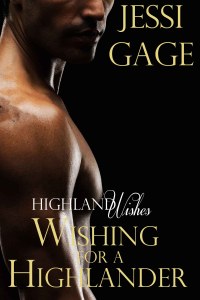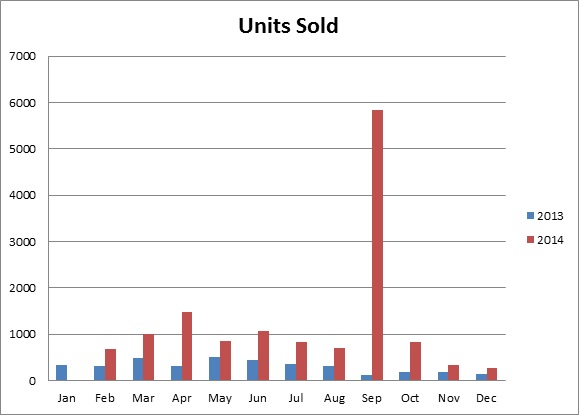The Numbers Are In!
About a year ago, I compared royalties for traditional versus indie publishing in a blog post. I had a unique perspective to offer since I did this comparison for the SAME book and close to the same month of different years, an opportunity afforded to me when the traditional small-press publisher I was with changed hands and gave authors the chance to ask for their rights back.
View the post here to see what I made in January 2013 as a traditionally published author versus what I made on the same book in February 2014 as an indie author (both were debut months). At the end of the post, I suggest I might do a similar comparison for a full year of traditional publishing versus indie publishing.
Well, here I am to do just that! Thanks for stopping by to peek! If you’re new to my blog, sign up for my newsletter over there on the right, and you’ll never miss any big Jessi Gage news.
 I’ll keep it brief (stop laughing).
I’ll keep it brief (stop laughing).
This comparison is for Wishing for a Highlander, which debuted the first time in February 2013 with a small press at a price of $5.99. It was also available in print for around $12 to $14 depending on the retailer.
Here’s the cover. I rather liked it.
Wishing was for sale from January through December for a total of 12 months of 2013.
 In February 2014, Wishing enjoyed a second debut, this time as an indie published title. It sold at all the same e-retailers for a reduced price of $3.99. The print price did not change.
In February 2014, Wishing enjoyed a second debut, this time as an indie published title. It sold at all the same e-retailers for a reduced price of $3.99. The print price did not change.
Here’s Wishing’s indie cover, created by the fabulous Kim Killion of The Killion Group. (Update 4/6/15): Now I have an updated cover for 2015 done by the amazing Damonza, but this is the lovely cover Wishing had for the sales period in this post.)
It was for sale from February through December for a total of 11 moths of 2014.
The Data
Here’s Wishing’s monthly sales for 2013 vs 2014. The blue bars represent units sold through traditional publishing (2013). The red bars represent units sold through indie publishing (2014).
The spike in September 2014 coincides with a BookBub promotion that ran for three days that month.
Total units sold in 2013: 3,699
Total units sold in 2014: 13,929
Here’s what Wishing brought home in royalties for 2013 vs 2014. The blue bars represent royalties paid to me by my traditional publisher (2013). The red bars represent royalties earned through indie publishing (2014).
Note that my highest earning month did not coincide with my highest selling month. This is a result of the BookBub promotion,during which I sold like gangbusters but at a lower price and a lower royalty rate on Amazon.
(Caveat: I did not take the time to calculate USD from foreign sales for the retailers that don’t make that conversion for me on the royalty statements. Amazon is one of these. In other words, the 2014 numbers are incomplete, but the numbers won’t be off by a whole lot since the vast majority of my sales are domestic.)
Total royalty earned in 2013: $5,139.69
Total royalty earned in 2014: $21,827.29
The Analysis
I sold 277% more units of Wishing for a Highlander in 2014 compared to 2013, and my earnings were 325% higher.
It’s that difference in percentages I want to call attention to more than the higher indie sales. As a traditionally published author, I received a smaller “slice of the pie” because more people had to get paid. It’s a simple fact of the industry that the fewer hands that touch your book, the larger the slice you get to keep.
In the case of Wishing, I was able to price it lower as an indie book and make about twice the royalty per unit moved. If you look at the charts again, you’ll notice the DIFFERENCE between the blue bars and red bars is much bigger for the earnings chart compared to the units sold chart (with the exception of my BookBub month, September). This demonstrates that “slice of pie” effect. I got to keep more of the pie, and readers paid less for the product.
This isn’t necessarily a plug for self publishing. See my post on my decision to go indie for reasons why traditional publishing is a perfectly valid and profitable option for many authors. But for some authors, indie can be a more profitable option if they are willing to put the work in.
The Conclusion
Self Publishing has been good to me.
Feel free to share this blog post. It’s good info for those considering which publishing track they want to take. In this post, I blog about the pros and cons of traditional versus indie publishing, and I reveal why I decided to go indie.
Are you an author with an indie or traditional-publishing story? Are these numbers surprising to you? Encouraging? Disappointing? I’d love to hear from you in the comments!
Thanks for reading, and don’t forget to SHARE, SHARE, SHARE using the nifty buttons below!










Hi Jessi, this is fantastic. Is there a comparison on the costs you would have spent going indie (for things like cover art and editing) versus trad publishing? I’m super interested since I am thinking of self-publishing in September. Thanks!
Hi Cd! Thanks for popping in!
I think I’ll do a post tomorrow about my self-publishing costs and taxes and such. That $21k number is deceptive, because there were significant expenses going in that a publisher would otherwise cover.
Thanks for the great idea for a new post! Stay tuned!
This is a great question because the traditional publisher numbers reflect that payment had already been made to the editors, book designers, cover artists, etc. Some of these costs you would not have incurred again because your book was polished before you went indie with it.
Absolutely, Kathryn! The expenses were significant. Drop by tomorrow for a pie chart. I’ll break down what kinds of expenses I had and what the overall expense amount was.
Thank you so much for sharing this Jessi! And also, woo hoo! Way to go, PK sister! 🙂
Thanks, Vicki! If only my contemporaries would do as well! It’s got to be a genre thing. Highlanders are hot right now, and I’m happily riding that trend.
I think I’ll do a post once all the final numbers are in on my experience and earnings vs name recognition on our Passionate Kisses Boxed Set.
Thanks for stopping by!
Good for you! I’ve had great success w/ The Killion covers too. Very encouraging. Now I just need to write a book. hmmm.
Kim does awesome work. She has pretty much single-handedly branded me. I’m so grateful to her.
I’d be happy just knowing how you sold 3K+ units with our publisher!? I think in 2013 AND 2014 combined I might have sold 18 units of RF (only 3 of those in 2014). Maybe. I might be overshooting that number. And you made $5k+ in royalties??? I might have cleared $25 (twenty-five is not a typo) in those same two years with the small press and the large one combined.
But, I am going to publish my first indie book this year so I’ll see how that one does in comparison to RF. This post definitely gives good reasons to give indie a shot!
Hi Calisa! Thanks for stopping by. I think Wishing’s success has a lot to do with the popularity of the Highlander & time-travel genres. I just happened to write in that genre, so there was certainly a lot of luck involved. My contemporary romance I had out with our publisher didn’t do nearly so well. I might have sold 25 the first month and then one or two a month after that. I’ve self-published that, and it has a beautiful cover and lower price, but it’s still not selling very well. Fortunately, I had the opportunity to put it in a boxed set. That will be a whole other blog post, lol!
Good luck with your books. They deserve way more attention!
I’m sure it’s all about what’s hot and what’s not in this business, Jessi. Anytime you want to visit the Ranch again just holler. 🙂 Thanks for the kind words sweetie.
Pingback: One Indie Author’s Debut Year Income | The Passive Voice | A Lawyer's Thoughts on Authors, Self-Publishing and Traditional Publishing
Hey Jessi! Congrats on a great year and here’s to many more. Thanks for being open with your numbers and sharing. 🙂 All best, Brenna
Thanks for stopping by, Brenna! I’m a chronic over-sharer, so it only seemed natural my indie income would be the world’s business, lol.
Thanks so much for sharing your numbers! I’m one of those writer’s who is deciding whether to pursue traditional or indie publication. I’m anxious to read your next post regarding the costs of your indie route.
Thanks for stopping by. It occurred to me as I was drifting off, that the royalty is only part of the story. So yes, I’ll be posting tomorrow with more info.
Thank you for your generosity in sharing your stats, Jessi. I decided two years ago to self-publish instead of sending out manuscripts and subjecting myself to endless rejections. My sales figures are similar to yours and I think you make a good point about writing in a popular genre. It makes your book so much more visible to the readers. I found using the pre-order facility on Amazon really helped push my book up the ranks in a short period of time. Reblogging.
Ooh, thanks, Jean! Reblogging is the bomb. Have you checked out Kristen Lamb’s blog? She’s got oodles of excelent info for indies, especially on social media for authors.
I’m on my way to Kristen’s blog, thanks for the links, Jessi, you’re a gem.
Reblogged this on Jean Reinhardt .
Congrats to you on a wonderful year! Here’s wishing you many more 😀
Thanks, Alan!
Great job! I’d love to see that breakdown of taxes and expenses.
The taxes will be an estimate for now. But the expenses, I’ve tracked them faithfully all year, so I’ll be able to report exactly what it cost me in publishing expenses and promotions. Look for the post tomorrow. Maybe there will be a pie chart.
Keep in mind that the author has to pay taxes on their traditionally published books’ earnings as well – so there’s not really a difference there between the two. 😉
Thanks, Anthea! It can definitely be a shock for someone coming from another inustry, but yeah, authors most likely know what they’re getting into tax-wise. I was lucky to have some great friends & critique parnters who warned me to set a good chunk aside for the tax man.
This was a really great post. And I appreciate you being so open with your numbers. It’s encouraging. I go back and forth all the time on if I want to try traditional or stay doing the indie route. While I can see the going traditional has a lot of its own perks, I think its nice just having my hands in the pot. I decide what happens to my books and how the cover looks and edited and marketed. And let’s not forget that 70% royalty 🙂 I only wish it was easier for me to get my name out there…. but I guess if I just keep on chugging along, staying steady with releasing new books, I’ll get there soon enough. That’s the dream at least.
Thanks for sharing …. and I still can’t wait for Wishing #2 😀
Thanks, Lonni! It’s a huge blessing, and I KNOW there was a lot of luck involved. I’m no Diana Gabaldon, but I’m super thankful to have so many happy readers out there supporting me!
Thanks for this post, Jessie, it’s such a help. I’m a new indie author and I didn’t know what to expect in my first year, especially as I rejected a publishing contract, and afterward wondered whether I had made the right decision. I’ll be posting my own stats later this week on my blog.
ooh, I look forward to that! I’ll go subscribe so I don’t miss the post.
That’s lovely of you, thanks, Jessie 🙂 I’ll be posting it today. Mind you, my sales are nowhere near yours.
Great post, Jessi. Thank you so much for publishing these numbers. Do you credit any of the increase in sales to the new cover? I like the old cover, but the Kim Killion cover seems a lot more “highlanderish,” do you think that made the book more marketable?
I ask because Jeannie Lin is collecting “cover change” data for a blog post at the RubySlipperedSisterhood and she circulated a Tweet yesterday asking for stories. You may want to contact her and share your experience.
Thanks for posting this, and congratulations on a great year!
I think it’s one of the factors, for sure. Also, there was the lower price, and the fact I shamelessly promoted myself. Oh, and I’d had a whole year’s woth of new connections via social media. I’m sure all those things made a difference.
Thanks for sharing your sales figures, Jessi, and congrats on the success. 🙂
Thanks Anthea!
Pingback: One Author’s Debut Year: Indie Income versus Expenses | Jessi Gage…A Time to Love
Reblogged this on Flash of Romance.
Hi. Thanks for sharing your experience. Sounds like a great book; the title’s terrific and it fits a niche that readers love. As a small press publisher, I was really interested to see the comparison between trad and indie sales. I’m not surprised that the reduced price worked so well — the original ebook was priced far too high for the market; your indie price was closer to the mark. Also, the original cover was bad; there’s no gentle way to put that. Not up to pro standards; it didn’t help sell the book. Your new cover is a thousand times more marketable. Last but not least, you went indie with a book that had been, in a sense, promoted for you by your publisher for a year before you re-launched it. That’s not a criticism, just a factor. In other words, this isn’t a simple case of “indie sells more than traditional publishing.” Every situation is different. Congratulations on finding the best way to manage your career, and here’s to more success!
Yes, yes, and yes, Deborah. You nailed so many of the factors that contributed to Wishing selling more as indie. I can’t think of any way to quantify a writer’s exposure in the market. You’re totally right in that I had a whole year to get my name out there before the second release of Wishing. It’s most likely a big factor in those increased sales.
Thanks so much for stopping by!
Fantastic post! I went indie as my first choice (YA Fantasy w/ heavy romance elements), and have had no regrets. I’ve earned more than I would have with an average first-time advance from a larger publisher, even after editing and cover expenses–and my book has only been out 9 months (with book two released last week–and that one covered its own expenses during the pre-order period).
I feel like there was luck involved, but I think my experience backs up your numbers here. Indie titles don’t need a publisher “pre-promoting” them before their indie release to see big numbers, and yours might have done just as well without that. We can do it on our own. We don’t have to have long publishing history, either (though I do wish I had more books out to offer readers who loved mine and wanted more!). I firmly believe that my book has sold more copies as an indie-first title than a small publisher would have moved.
We all have to do what’s right for our books and our careers, whether that means traditional or indie publishing. Thank you for sharing your numbers to help others make their own informed decision.
Thanks for reading, Kate. Would you mind posting a link to your website or blog here? I want to go look at your books. They must be excellent for you to have “hit” with your debut. Congrats to you!
Sure! I’m at http://www.disregardtheprologue.com most of the time.
And congrats to you, too! (and thanks again for sharing your info. I’ve got it bookmarked to link back when I need it)
Reblogged this on The Writers' Room.
Thanks so much for the reblog!
Enjoyed the comparisons. Is there a breakout of print versus e? I’m presuming the majority were ebooks?
Oh yeah, big time e-book advantage. You have to pay $9 for the print version! The ranking for Wishing in print is in the millions, so I’m thinking it hasn’t sold in print in a while.
Thanks for stopping by!
Pingback: BookReport is the Icing on the Cupcake | Jessi Gage…A Time to Love
Pingback: Friday Link Pack 04/17/15 | I make stories.
Pingback: Romance Junkies Blog | Author Jessi Gage
Pingback: What Indie Means to Me | Jessi Gage…A Time to Love